#late Baroque fashion
Photo


Some 1690s (from top to bottom) -
ca. 1690 Beatrice Violante of Bavaria, Grand Princess of Tuscany by Bartolomeo Mancini (Museo Civico Pinacoteca Crociani - Montepulciano, Sienna, Toscana, Italy). From tumblr.com/roehenstart 1280X1492 @72 685kj.
ca. 1693 Comtesse de Balleroy by Nicolas de Largilliere (Aguttes - 6Dec22 auction Lot 48). From their Web site 2224X2798 @144 6Mp.
#1690s fashion#late Baroque fashion#late Louis XIV fashion#Beatrice Violante of Bavaria#Bartolomeo Mancini#curly hair#hair jewelry#cap#off shoulder V décolletage#lace modesty piece#notched over-sleeves#lace cuffs#Comtesse de Balleroy#Nicolas de Largilliere#wavy hair#cleft coiffure#V décolletage#over-dress#jeweled girdle#V waistline#jeweled clasps
164 notes
·
View notes
Text
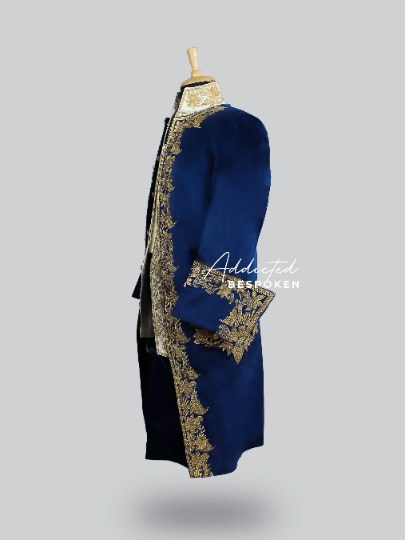
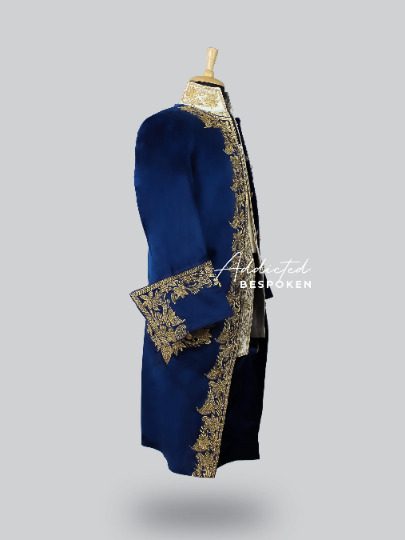

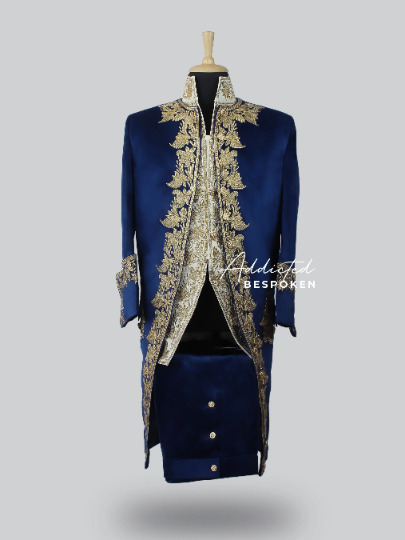

Men Blue Velvet 3pc French Nobleman Costume 18th Century Inspired Carnival Of Venice Rococo Wedding Outfit With Free Lace Jabots And Cuffs
This 18th Century vintage costume for men is inspired from the magical Venical Carnival & Late Baroque fashion.
The costume can become the zest of any carnival or themed festival and can also be a perfect costume for wedding groom.
This 3Pc court suit include:
•Blue velvet justaucorps embellished with paisley & floral embroidery & metal button detailing
•Off white paisley print vest embellished with paisley & floral embroidery & have button closure
•Blue velvet Breeches with floral embroidery on bottom & metal button detailings & closure
•Laced jabots & cuffs
Features:
•Intricate embroidered
•Lightweight
•Soft & Breathable
•Comfortable wearing in all seasons
Material & Caring:
•Premium Velvet & Eco friendly material
•Dry Clean
•Dry on low heat or hang to dry for best result
#Men's costume#18th century fashion#Late Baroque Fashion#French formal suits#Roccoco costume#Period costume#Rococo Suiut#Casanova costume#Noble Court Rococo#Colonial Outfit#Tudor costume#Court coat suit#Historical costume
5 notes
·
View notes
Text
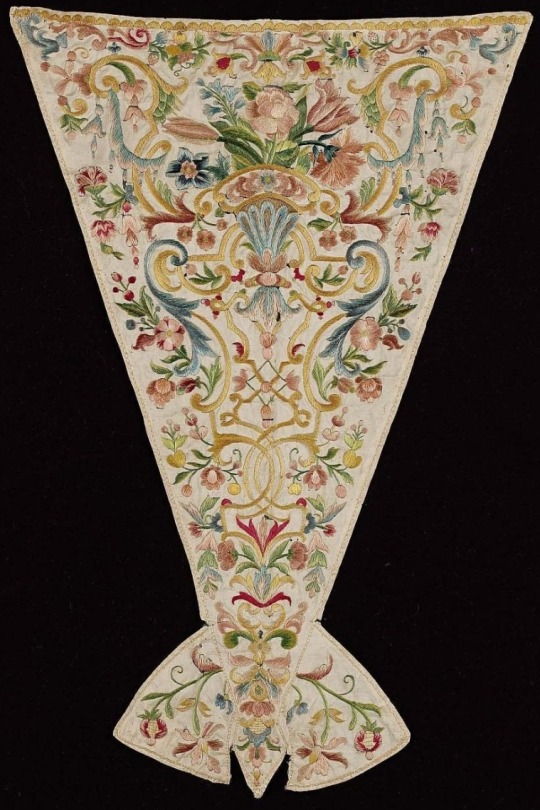
Stomacher
Italian
early 18th century
silk, embroidery
#historical fashion#fashion history#18th century fashion#18th century#baroque fashion#late baroque fashion#embroidery
1 note
·
View note
Text
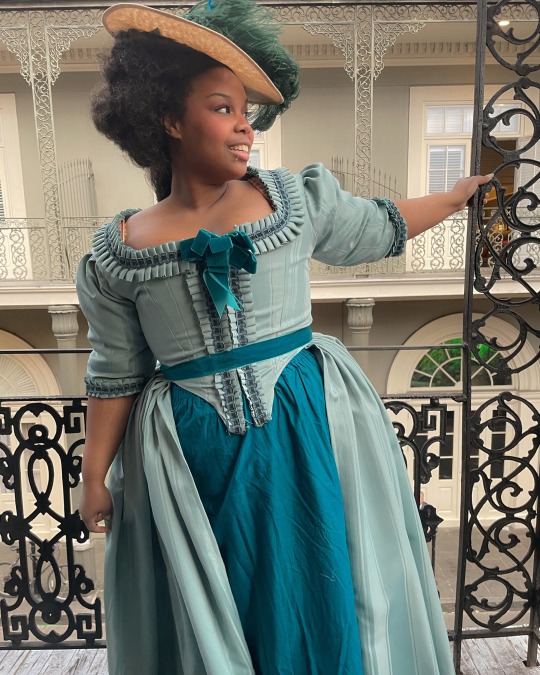
from this post
#rococo#late baroque#historical fashion#historical costuming#historical costume#1780s#18th century#18th century costume#teal aesthetic#black people in period clothing#black people in historical costume#mignonne#2023#blue
2K notes
·
View notes
Text

a snap from the fête. // IG
#rococo#marie antoniette 2006#marie antoinette#late baroque#pastel aesthetic#historical clothing#historical costume#princesscore#fairytale aesthetic#white aesthetic#white dress#18th century#18th century costume#18th century fashion#mignonne#2022#robe à la française#robe a la francaise#pastel purple
833 notes
·
View notes
Text
Historical Costumes of England from the Eleventh to the Seventeenth Century
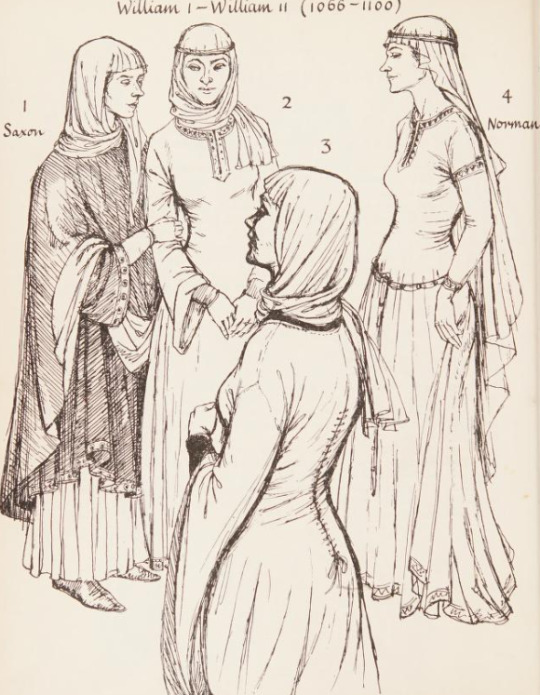
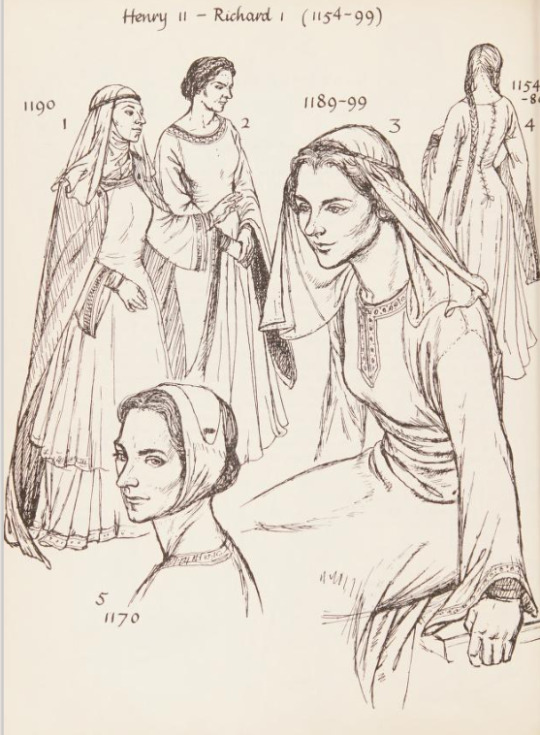
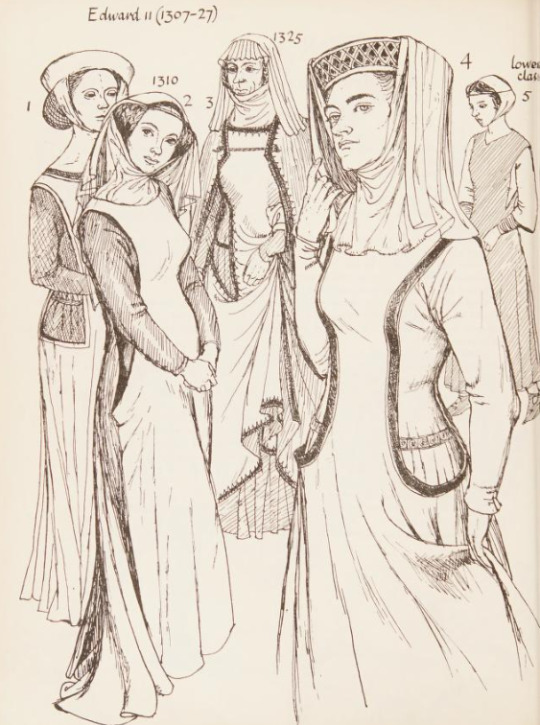
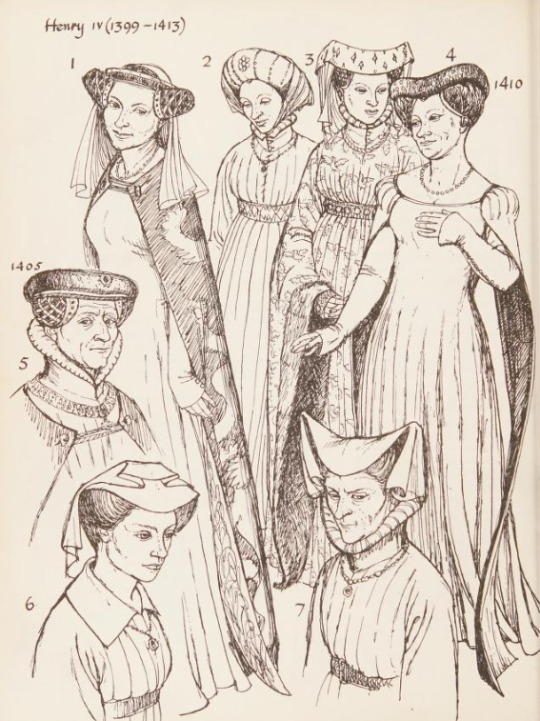
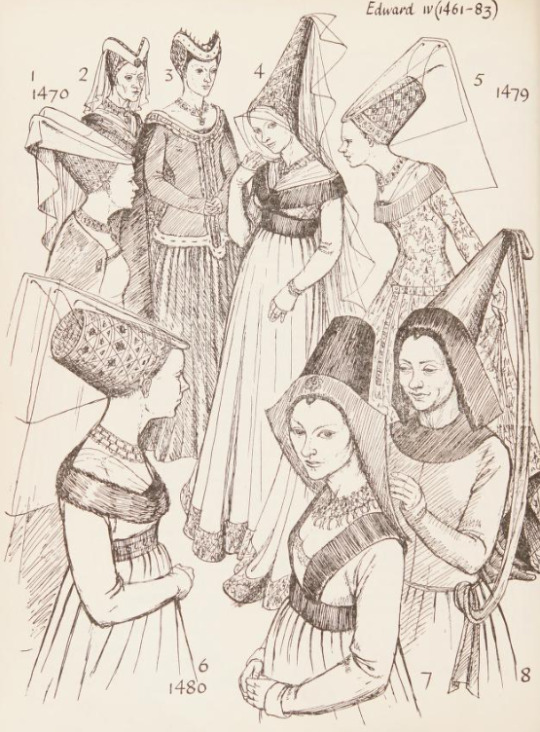

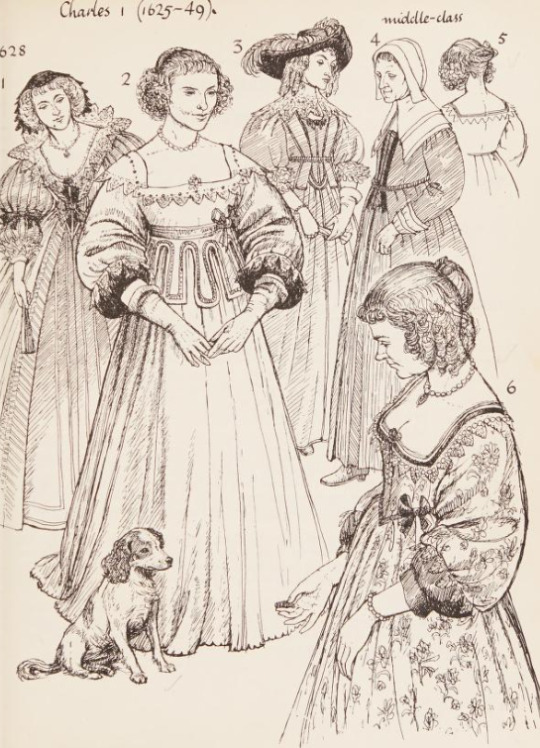
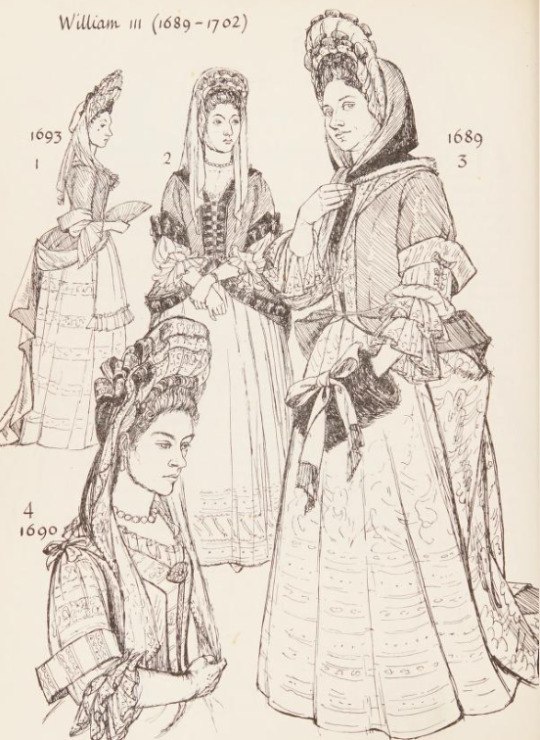
- Nancy Bradfield, 1963
285 notes
·
View notes
Note
There is no way to say it pleasantly. Your recent post about Julie... its speculation is a slap in the face of masculine women. Dressing in men's clothing is not a statement against being female, especially in times when male clothes were far more practical than women's. (And especially in the case of a bisexual or homosexual woman!) Behaving "unwomanly" is evidence only in the eyes of sexists. But even today... it is stunning to think that a woman, should her every thought not be recorded, could be deemed a secret man for being masculine! That lingering speculation, despite absence of proof, is rather insulting.
Your reading of my post is extremely dishonest or you didn't actually read the post. The whole time I talk about her as a sapphic woman, because that is what the evidence most point towards. If you think even raising the possibility that she might have been somewhere in the genderqueer or trans spectrum (like some butch lesbians identify as genderqueer and/or trans too), is an insult and means I'm sexist or some shit, there's no way to say it pleasantly, you're probably just a fucking terf.
Now I have no illusions that correcting some of the inaccurate things you said will do anything to change your mind, but because we're already here and I'm allergic to these bad fashion history takes, I'll correct them anyways. This is more for anyone else who happens to see this and actually has some level of reading comprehension.
The women's dress at the time was not necessarily any more impractical than the men's dress. The impractical part of high society women's dress was the skirt that usually had a large trail. But they would also have much more practical dresses for casual usage. High society men wore large wigs that were I would assume pretty impractical. Their clothing, which was well fitted around the torso, closed with buttons and then not very easily adjustable. On the other hand the women's dress was either loose and pinned and belted to fit (in the case of mantua) or laced (in the case of rigid gown) so very easily adjustable even during the day to keep it comfortably fitted to the changes in the body. This would be more practical for anyone, but especially to most afab people, whose bodies can change quite drastically thorough the month.



My point is actually no Julie de Maupin did not have any practical reason to dress in men's clothing. In fact it was impractical for her. As I point out in the post she struggled with the leading female roles, which she wanted to get, partly because her off-stage personality clashed so much with them. (At first) she didn't get as much recognition of performances in leading roles as in supportive roles, partly because the audiences had trouble buying her performances in those roles.
And the other point. The modern concept of fashion doesn't entirely apply to the past. Now fashion is seen as self-expression. Even being into fashion is seen as an indication of certain personality. This was not the case in the time when Julie was alive. Back then fashion was much more social decorum. To be able to participate in the high society you had to keep up with fashion. There were people who were more fashionable than others, sure but they were mostly just the richest young people around, and that made them most fashionable. Fashion was not for self-expression, it was mostly for expression of hierarchy. It was also for political expression. (There's an interesting paper on the contemporary commentary of the politics of the court fashions, which I will link here, when I'm on my desktop.) It was not about what you wanted to wear, but what you wanted others to think about you.
In addition to that at the time clothing was integral part of gender (arguably still is judging from all the conservatives loosing their minds when a man dares to wear a dress). Women in breeches and men in skirts were seen as transgressing on gender. This can be seen even in the mid 1600s conservative reaction to when women's riding habit first appeared (they never change do they?). They complained that the women were basically indistinguishable from young pretty men and like the women were even wearing skirts (seen below)? Part of this was that both the women and men were shaping their silhouettes with their clothing to gain the fashionable feminine and masculine silhouettes, which meant that different shaped bodies could still achieve either silhouette.

Looking through this lens we can ask, why did Julie wanted to be seen as transgressing on gender even though it hindered her career? I think there could be many answers to this question and one could be that she wanted to be seen as not-woman (or maybe not entirely woman). We can never know, because we don't have any of her thoughts about her androgynous expression surviving to this day.
#sorry but like you didn't take me at good faith so i won't take you either#answers#fashion history#historical fashion#queer history#late baroque#julie d'aubigny#julie de maupin#anon
130 notes
·
View notes
Text
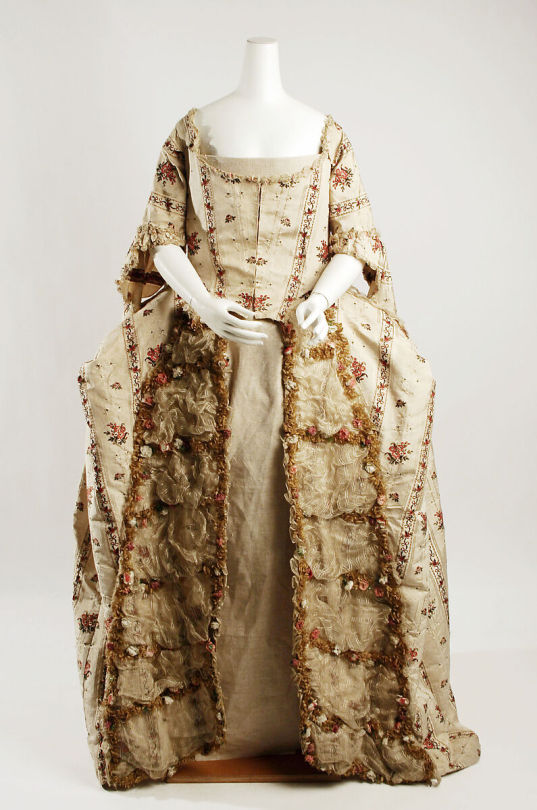

Robe à la française, c. 1760-70
#history#art history#fashion history#baroque#rococo#antique#romantic academia#light academia#light acadamia aesthetic#romantic academia aesthetic#18th century#late 18th century#1700s#late 1700s#french#silk
32 notes
·
View notes
Text
It’s that time of the year when I pretend I’m not a trash goblin


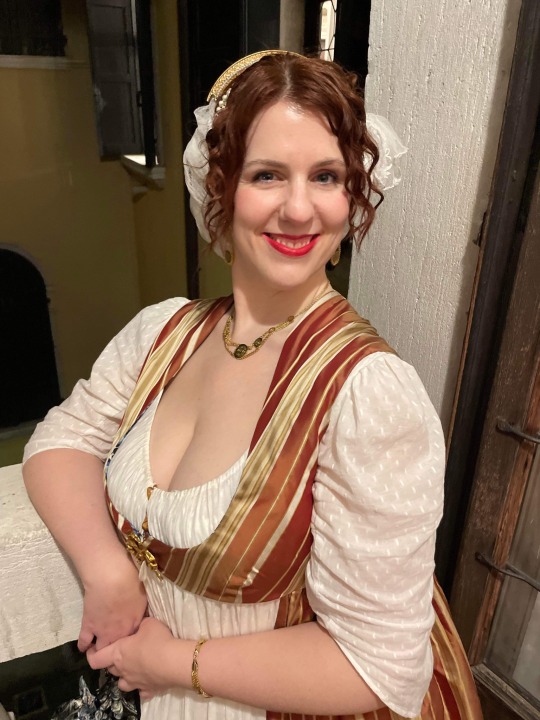
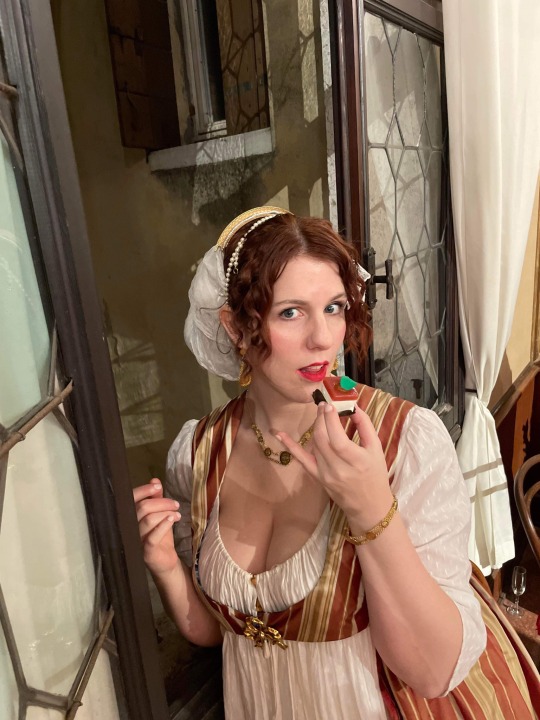

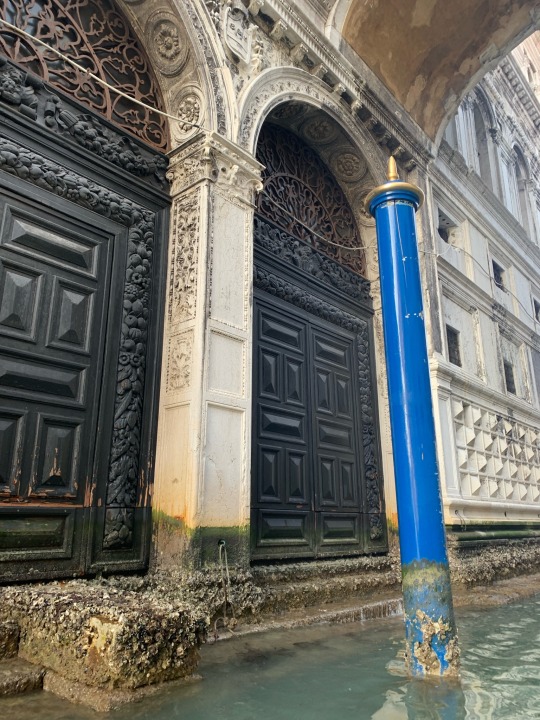



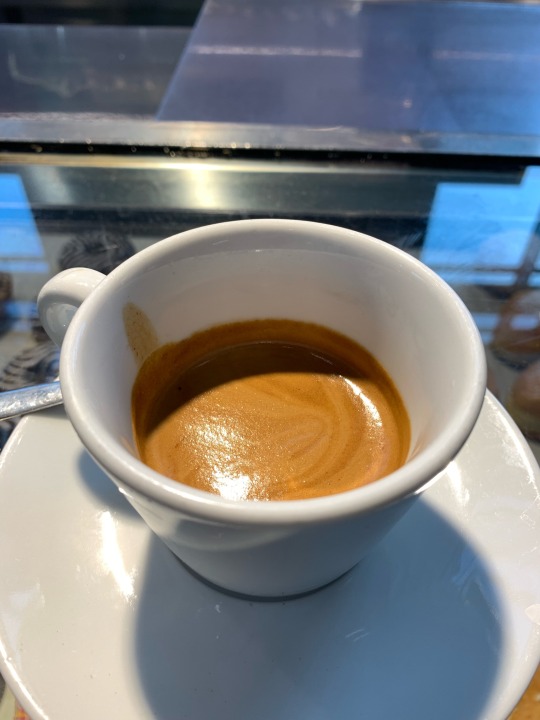
#carnevale 2023#carnevale#carnevale di venezia#historical costume#historical costuming#baroque#17th century#17th C#1790s#1790s fashion#regency era#italian renaissance#late 1400s#early 1500s
18 notes
·
View notes
Text
Early 18th (and late 17th) century fashions are so under-utilized in vampire media and I think it's a damn shame.
I don't actually think I've ever seen a single image of a vampire character in an early 18th century suit. Hardly any movies set in that era either, and hardly any historical costumers who do it.
(Even my beloved gay pirate show set in 1717 takes nearly all of its 18th century looks from the second half of the century. Not enough appreciation for baroque fashion!!)
Yes I love late 18th century fashion as much as anyone, and 19th century formal suits are all very well and good, but if you want something that says old, dead, wealthy, and slightly dishevelled, then the 1690's-1730's are where it's at.
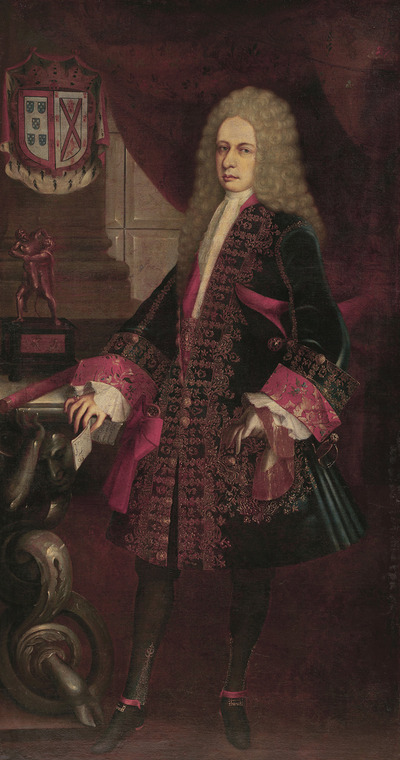
(Retrato del Virrey Alencastre Noroña y Silva, Duque de Linares, ca. 1711-1723.)
There was so much dark velvet, and so many little metallic buttons & buttonholes. Blood red linings were VERY fashionable in this era, no matter what the colour of the rest of the suit was.

(Johann Christoph Freiherr von Bartenstein by Martin van Meytens the Younger, 1730's.)
The slits on the front of the shirts are super low, they button only at the collar, and it's fashionable to leave most of the waistcoat unbuttoned so the shirt sticks out, as seen in the above portraits.

(Portrait of Anne Louis Goislard de Montsabert, Comte de Richbourg-le-Toureil, 1734.)
Waistcoats are very long, coats are very full, and the cuffs are huge. But the sleeves are on the shorter side to show off more of that shirt, and the ruffles if it has them! Creepy undead hands with long nails would sit so nicely under those ruffles.
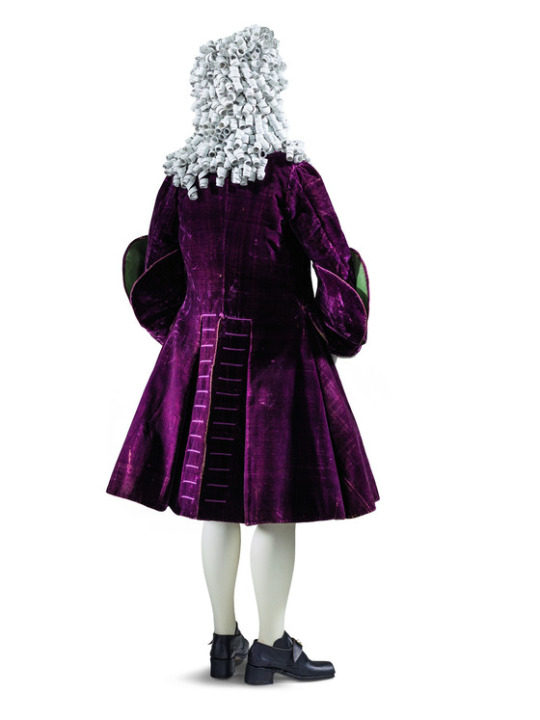
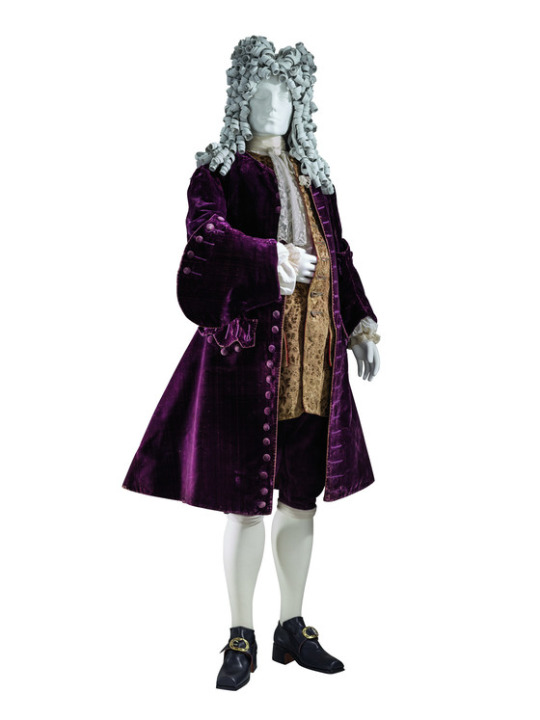
(1720's-30's, LACMA)
Embroidery designs are huge and chunky and often full of metallic threads, and the brocade designs even bigger.
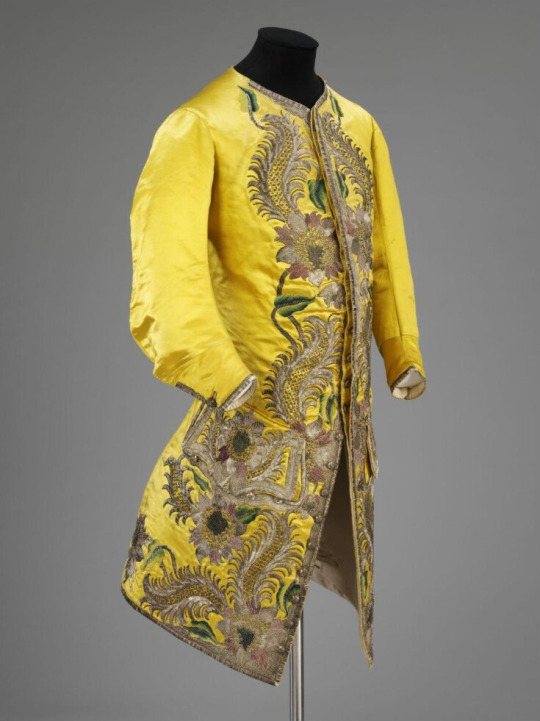
(1730's, V&A, metal and silk embroidery on silk satin.)
Sometimes they did this fun thing where the coat would have contrasting cuffs made from the same fabric as the waistcoat.
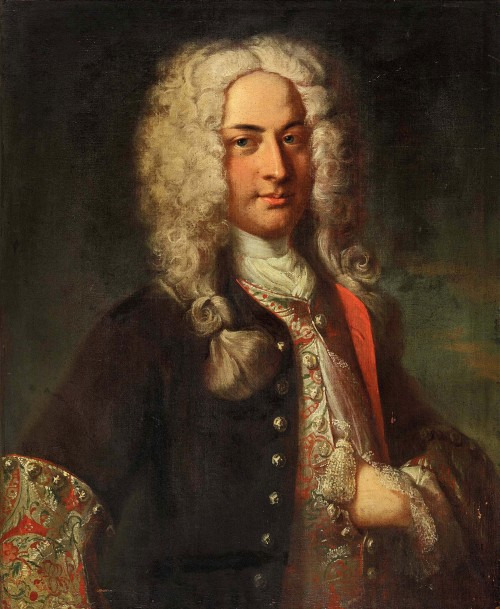
(Niklaus Sigmund Steiger by Johann Rudolf Huber, 1724.)
Tell me this look isn't positively made for vampires!
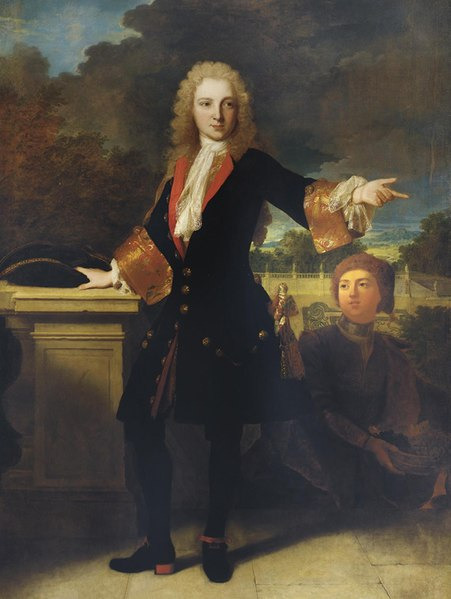
(Portrait of Jean-Baptiste de Roll-Montpellier, 1713.)
(Yeah I am cherry-picking mostly red and black examples for this post, and there are plenty of non-vampire-y looking images from this time, but you get the idea!)
And the wrappers (at-home robes) were also cut very large, and, if you could afford it, made with incredible brocades.
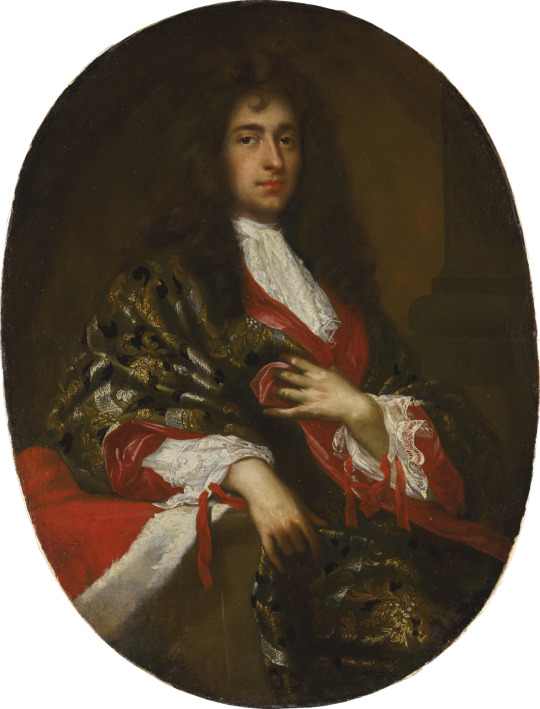
(Portrait of a nobleman by Giovanni Maria delle Piane, no date given but I'd guess maybe 1680's or 90's.)
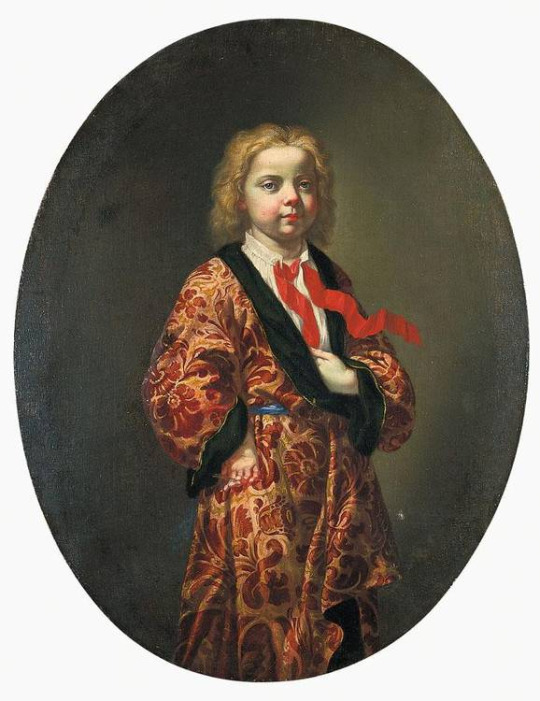
(Circle of Giovanni Maria delle Piane, no date given but I'd guess very late 17th or very early 18th century.)
Now that looks like a child who's been stuck at the same age for a hundred years if I ever saw one!
I don't know as much about the women's fashion from this era, but they had many equally large and elabourate things.

(1730's, Museo del Traje.)

(Don't believe The Met's shitty dating, this is a robe volante from probably the 1720's.)

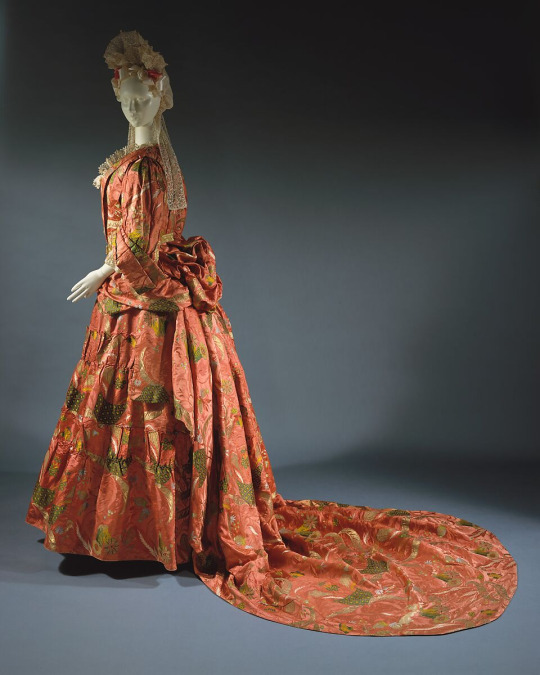
(Mantua, c. 1708, The Met. No idea why they had to be that specific when they get other things wrong by entire decades but ok.)

(Portrait of Duchess Colavit Piccolomini, 1690's.)

(Maria van Buttinga-van Berghuys by Hermannus Collenius, 1717.)
Sometimes they also had these cute little devil horn hair curls that came down on either side of the forehead.
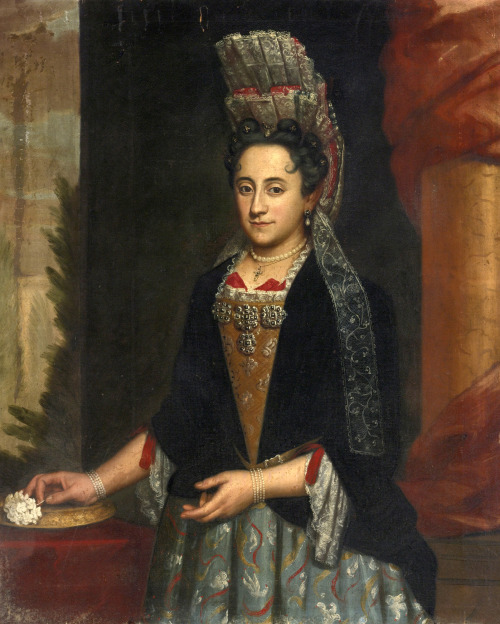
(Viago in drag Portrait of a lady, Italian School, c. 1690.)
Enough suave Victorian vampires, I want to see Baroque ones! With huge wigs and brocade coat cuffs so big they go past the elbow!
#long post#vampires#fashion#history#18th century#17th century#someday. SOMEDAY I will make a black/red/dark orange/metallic gold 1720's suit#I've got nearly all the materials I just need to:#1. Learn how to make early 18th century metallic thread buttons‚ preferably without having to buy the super expensive kind of thread#2. get a wig and style it appropriately
2K notes
·
View notes
Text
My Fair Lady: Late Baroque Era Set

(no fancy thumbnail this time, sorry) ♫ < baroque music
Please READ ALL OF THIS before downloading. I will not answer an ask if it was answered here. Read.
This is a late 17th-century/early 18th-century Baroque Set. You will get 25 items for women, girls, and toddlers! Towards the bottom, I will give you tips to start a Baroque Era Save (people to find on gallery and men/boy attire).
I would like to thank @the-melancholy-maiden @linzlu @sychik @batsfromwesteros @vintagesimstress @cringeborg @acanthus-sims @stereo-91 and sims 2 creator maya40 for the stuff I've used to make all of this. I'm sure there are more creators but I cannot recall their names off the top of my head. DM me if you see a piece of your mesh here so I can give proper credit. I would also like to thank @belleophile for testing these items for me.
The stuff in this set can work for the late 1660s-early 1710s.
WHAT YOU GET: You will get 3 hat hairs, 1 for each age I listed above, 2 Fontanges for adults that work with the hat slider mod, 4 adult hairs, an adult baroque hair comb piece, 1 adult baroque sash accessory used for court and portraits, 1 ribbon hair piece to go with a hair, and 13 dresses (2 1670s/1660s mantuas, 1 1680s-1710s Habit used for Hunting or Riding, 1 1690s-1710s court dress used for court occasions, 1 1690s-1710s jeweled portrait dress and 1 1660s-1670s portrait dress with sash, and finally 7 1690s-1710s mantuas used for everyday, formal, and seasonal wear. I've included 1 dress for a child and 1 dress for a toddler as well).
SMALL NOTICE ABOUT THE PIECES: The hairline on the hairs will not behave correctly if you have head shape presets on the sim. I've tried fixing that but no luck. If I manage to fix it, I will update it. The Hat Hairs are found in the HAT category and are not compatible with hairs you MUST download the hair files that I'll be including with them. This being said, if you remove sim clothing while they have the hat hair on, it removes the hair override too. It's strange, but just put the hat back on and it should fix. The comb, and ribbon accessory are also found in the hat category. The Sash is found in the GLASSES category. The 1660s-1670s Mantuas are not compatible with shoes, leggings, or socks. I've removed these options in CAS tools so you shouldn't have to worry about clipping. The Barbara 1670s Dress has a sash meshed onto it, and because of this does not behave well with bigger bodies. The same applies to the Henrietta 1670s Dress, as the pearls don't behave with bigger bodies. Same with the Sarah 1670s Dress jewels. The 1690s-1710s Mantuas will have small gaps if the sim is plus-sized. I have tried to fix these issues, but no luck. The hat hair fontange looks a bit gray without reshade or a lighting mod. @northernsiberiawinds has some good lighting mods. Other than that, it's fine. Below, is how it will look white with a lighting mod.



Everything has AT LEAST 20 swatches. Some things have more. There are only a few things that don't have this many swatches.
Here are some pics up close of what you are getting.
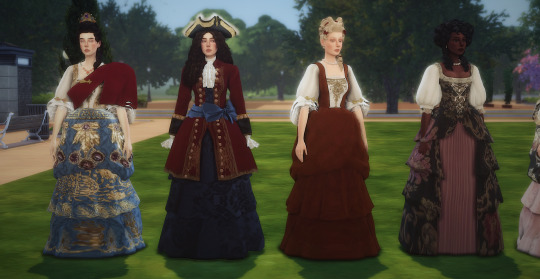

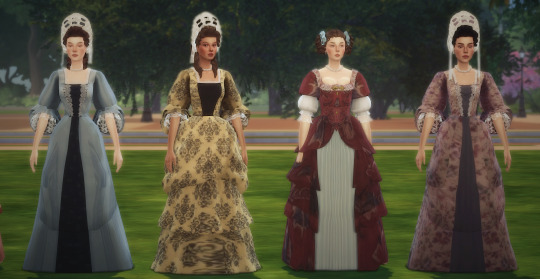
Here are some pics/fashion plates from this era.
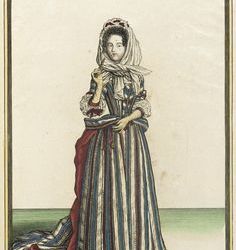
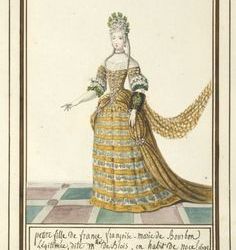

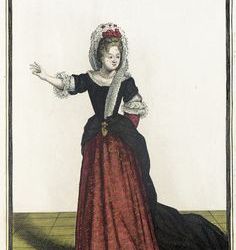
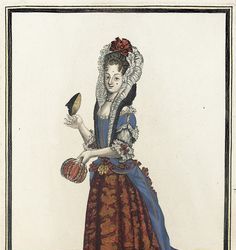
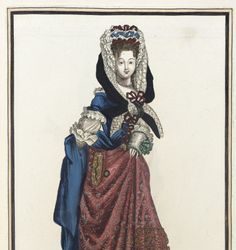
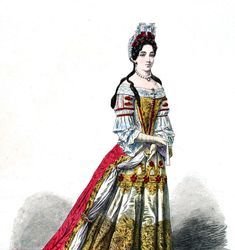
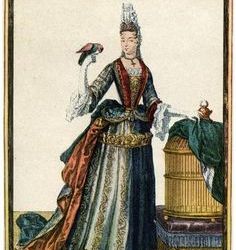

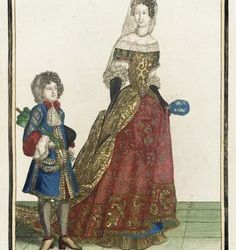
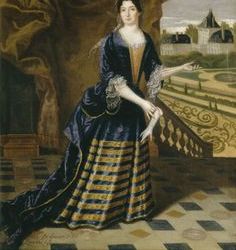

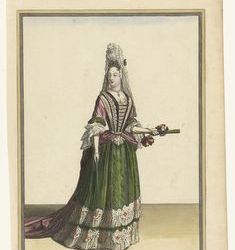
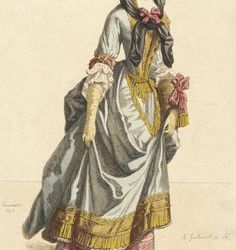

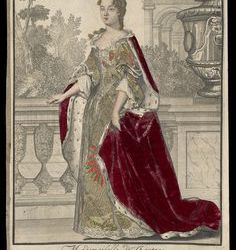
Did I forget the 1680s mantua..? Oh no! Luckily, I've included this surprise 1680s dress you'll be getting as well for reading all of that. So 26 items! (here you can see hat hair fontange without lighting mods installed)
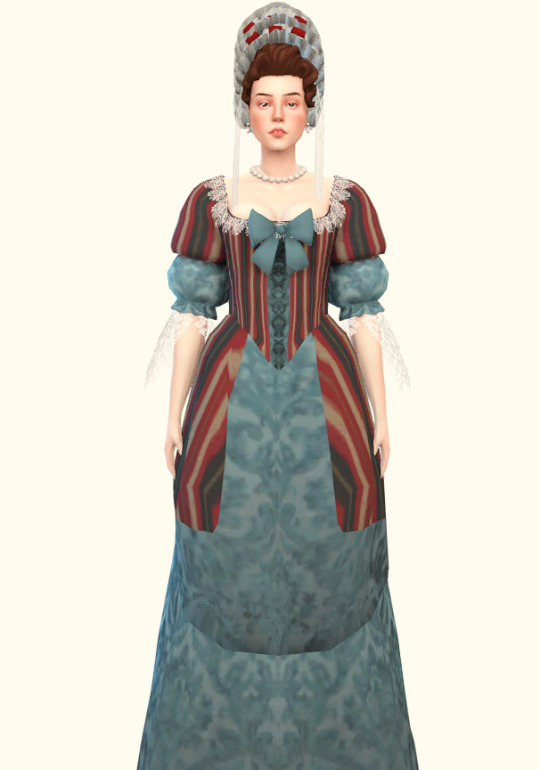
BAROQUE SAVE TIPS: These dresses will work for winter, summer, and traveling wear. Just add a fichu for summer wear or a shawl. For winter wear just add some long gloves and a cape. For men's stuff from this era, @stereo-91 has recolored some acanthus outfits which can be found here. I'll show you how they look below. I also recommend going to his gallery (ROTAMETERS91) as he has AMAZING builds for this era. For a little boy, @acanthus-sims has some stuff that can work.
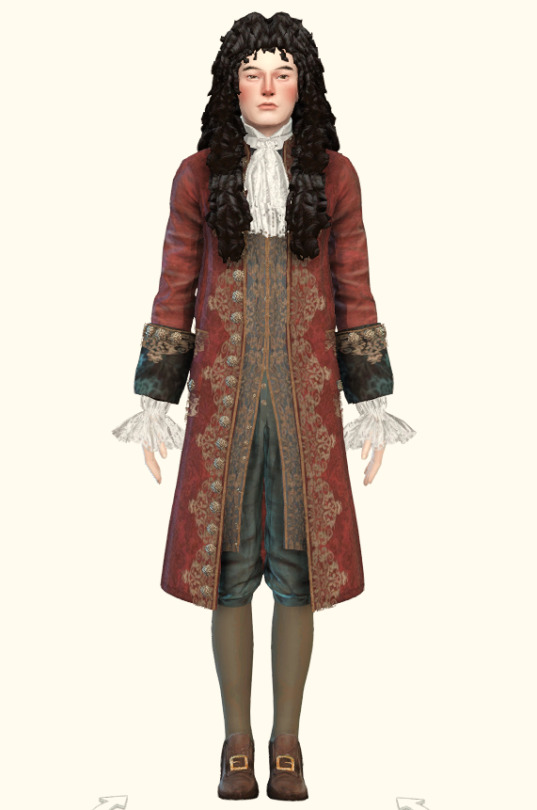

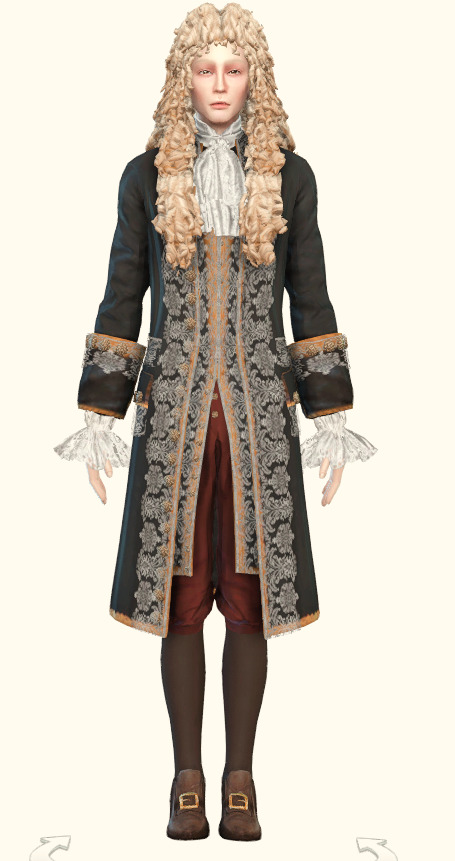
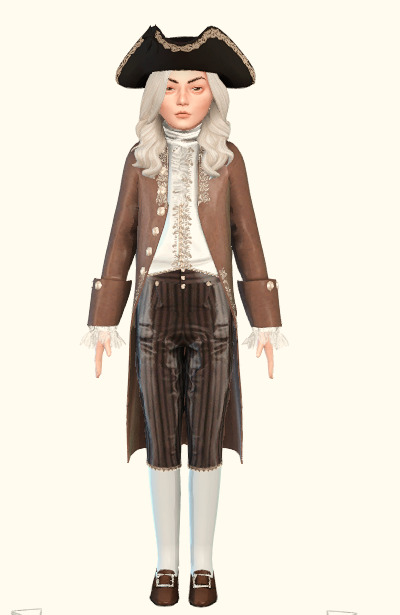
DOWNLOAD
#baroque ts4#baroque sims 4#sims 4 baroque#sims 4 decades#my cc#historical cc#ts4 cc#historical sims 4#sims 4 historical#historical sims#sims 4 cc#the sims cc
343 notes
·
View notes
Photo

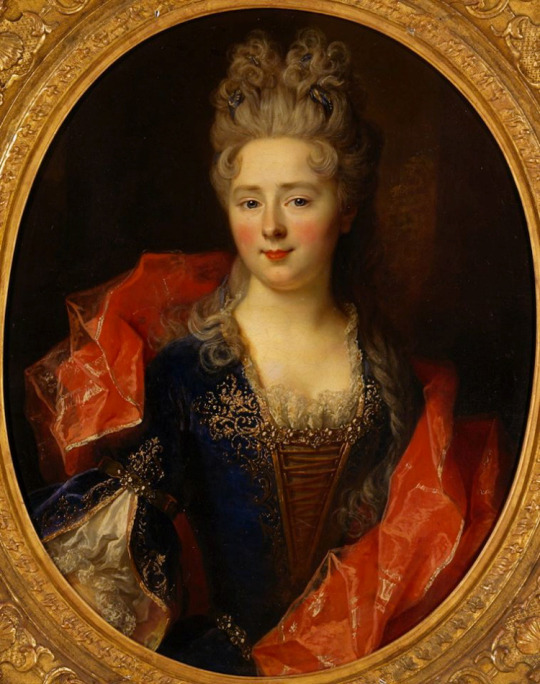

Late Louis XIV - Fripon curls and cleft coiffures (from top to bottom) -
1690s (late) Female portrait by Nicolas de Largillière (State Pushkin Museum of Art - Moskva, Russian Federation). From pinterest.com/pocketmuseum/1600-1699-women-in-works-of-art/1690s/ 1875X2420.
ca. 1700 Une élégante dame by Nicolas de Largillière (location ?). From tumblr.com/sims4rococo76.
1700s Lady with a dog and a monkey by Nicolas de Largillière (Muzeum Narodowe w Warszawie - Warsawa, Poland). From Wikimedia 1782X2353.
#1690s fashion#1700s fashion#late Baroque fashion#late Louis XIV fashion#Nicolas de Largillière#curly hair#cleft coiffure#hair ornaments#fripon curls#lace-edged chemise#modesty piece#vest#flared sleeves#laced bodice#three-quarter length sleeves
29 notes
·
View notes
Text
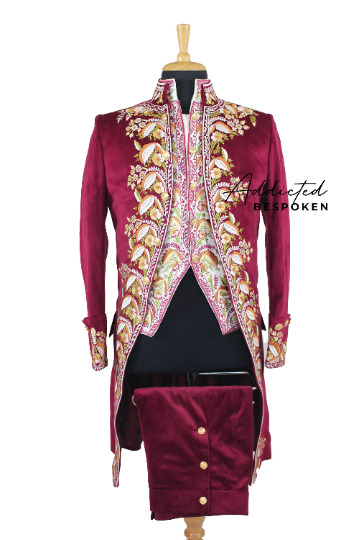
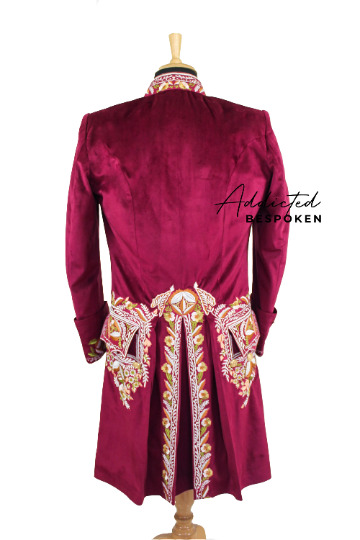

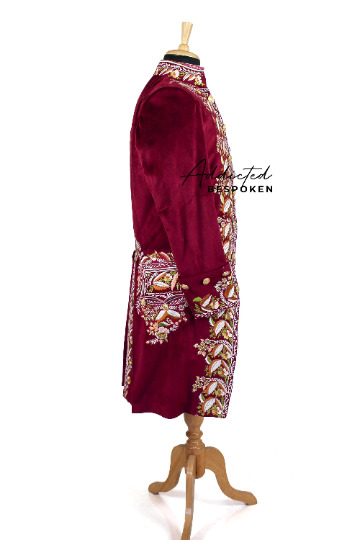


Men Red Velvet 3Pc Fersen Court Suit Period Clothing Floral Embroidered Metallic Detailings French Nobleman Costume Free Lace Jabots & Cuffs
This 18th Century vintage costume for men is inspired from the magical Venical Carnival & Late Baroque fashion.
The costume can become the zest of any carnival or themed festival and can also be a perfect costume for wedding groom.
This 3Pc court suit include:
•Red velvet justaucorps embellished with Victorian floral embroidery & metal button detailing
•Off white paisley print vest embellished with Victorian floral embroidery & have metal buttons closure
•Red velvet Breeches with floral embroidery on bottom & metal button detailings & closure
•Laced jabots & cuffs
Features:
•Intricate embroidered
•Lightweight
•Soft & Breathable
•Comfortable wearing in all seasons
Material & Caring:
•Premium Velvet & Eco friendly material
•Dry Clean
•Dry on low heat or hang to dry for best result
#men period clothing#carnival costumes#masquerade costumes#venetian costume#18th century fashion#1780's men costume#vintage clothing#colonial costumes#men rococo costume#late baroque fashion#fersen court suit#french court suit#frock court suit
1 note
·
View note
Note
do u have a specific year in mind or is it just general 16th century vibes
Very late 16th century. I'm reluctant to assign them specific years because I prefer to have just a little bit of wiggle room, I'd go crazy if I had to map out their timeline to follow real life historical details to a T (it's not impossible to do that by any means, I'm just not strong enough weh). For example, I tend to use a lot of early to mid 1500's references for Vasco's wardrobe, by the end of the century fashion had already started to take somewhat darker and more rigid direction and I like to keep Vasco's attires colorful, voluminous and eyecatching. Mostly to highlight their visual contrast to Machete's angular and constricted silhouettes and predominantly black palette.
I keep calling them late Renaissance dogs but in truth they're closer to early Baroque. At the moment I'd say they were probably born in the 1570's, Vasco is a couple years older than Machete but in the grand picture they're practically the same age. In the bad ending Machete dies in his early/mid 40's, that would mean a little after the turn of the century. Vasco lives to his 70's so he'd still be around in... 1640, right? But again, I don't like giving them fixed dates, I'm just thinking out loud. Might go back and retcon this in the future if I change my mind in a way or another.
221 notes
·
View notes
Text
notes on "mr. snarl"
hello, hello, hello welcome to the mr. snarl is high camp discourse. i've been readin' and thinkin' and drivin' myself nuts over this, so i'll be blabberin' on for a good minute. bear with me.
before we dive into any discussion of camp, we ofcourse need to understand what camp is in the first place. camp as an idea is nearly impossible to neatly put down in a few words or a sentence. it has no definition as of such. camp is loud. camp is ostentatious. camp is exaggerated. camp is 'too much'. camp is gay. camp is ironic. camp is cheeky. drag is camp. marlene dietrich is camp. baroque art is camp. cher is camp. mommie dearest (1981) is camp. the rocky horror picture show (1975) is camp. dostoevsky is camp.
the girlies who get camp get it, those who don't, don't.
however we do have susan sontag's 1964 seminal essay 'notes on "camp"' from where most of our contemporary ideas and understanding of 'camp' comes from. in her essay, sontag noted 58 points on what camp is or might be. for our purposes in this post, we'll go by those. because it is the camp bible of course. and i am a pretentious bitch.

now before we get to the meat of the matter, a quick detour to discuss the many faces of alex turner.
alex's personas have now come to as closely associated to his image as an artist and public figure as blonde wigs are with dolly parton, i suppose. it even has its own section in alex's wiki page. he is one those performers to whom the "eras" concept can truly and perfectly apply. he is a different man on stage with every new album, each 'era' is unique from the other and distinctly defined. a new 'era' for alex is not only a change of a haircut or a new pallette, it is a total revamping of his mannerisms and performance style and public image. be it mr. schwarz (the car era), mark (tbhc era) or oliver tate sr. (early sias era), each one of his personas is another way in which he represents the themes of that album. understanding a persona is integral to understanding the album.
and alex admits to as such. each Performer is a fractured reflection of his own self, and of the album.
but. but. i do not think that he has always made use of the Performer, or atleast, tried to make perceivable distinctions between them. in the first three-four years of his career- during WPSIATWIN and FWN, he presented as just Some Guy. just another normal bloke from sheffield. which, you could argue, was the persona that fit the context of those albums, but i would say that he was probably not putting that much thought into it at the time. it isn't until TAOTU that we see alex using his on-stage fashion to project a certain kind of image that ties in with the music he's playing. (do i think it's miles' handiwork? yes.). the lil suits and ties and beatles-mop cuts, y'know.
the first distinct Performer appears during the Humbug era. the soft-spoken, brooding, fawn-mannered poet who is probably hiding a bagful of secrets and hang-ups behind those layers of brown curls- let's call her him aly. then we have the bright-eyed, puppy-smiled, deep-voiced loverboy of the early SIAS era. i propose to call him oliver tate sr. (after the guy from submarine (2010) obviously). then mr. snarl- we'll get to him later. the loud and theatrical and slutty and deliciously gay EYCTE era persona. then the melancholic space poet mark of TBH&C and finally the suave auteur of The Car- mr. schwarz.
mr. snarl is the one who has garnered the most fascination and endured the most in popular imagination. dare i say, AM-era alex turner is a lowkey late 2010s pop culture icon. it is very easy to understand why- the quiff, the leather jackets, the perpetual sunglasses, the biker boots, the LA drawl tinging his sheffield accent, the devil-may-care wantoness. the girlies on tiktok and pinterest aren't obsessed with him for nothing.
so, what makes mr. snarl camp? what am i yapping on about?
let's get back to sontag.


camp is artificial. camp is ironic. mr. snarl is too. he is a character. he is a mask. *cue the bourne identity and body paint*. 'artificial' does not imply fake or dishonest. we should be careful not to be quick in putting any value judgement onto this artificiality- the aritifice is a quality of camp. you can't appreciate camp, if you snigger at the artificial.


2. camp is character. mr. snarl is a character if there ever was one. extremely defined, visually and behaviourally- you see a performance and can immediately recognise the moment mr. snarl is peeking through. he is also very intensely one thing- very intensely masculine, very intensely rockabilly, very intensely rock god. he is 'instant character' as sontag puts it, which is why perhaps he so immediately and so firmly gripped our collective imagination.



3. camp is exaggerated. camp is style. do i even need to elaborate on this? Ben Beaumont-Thomas of The Guardian said it much better than i could- alex ironically "played with the role" of being a rockstar but simultaneously "can't help but be a real rock star." so, to put it in sontagian terms, he is not a rockstar but a "rock star"

the 2014 brit awards speech is the peak of this ironic, exaggerated performance i think. (i'm still waiting for someone to do a drag performance based on it).
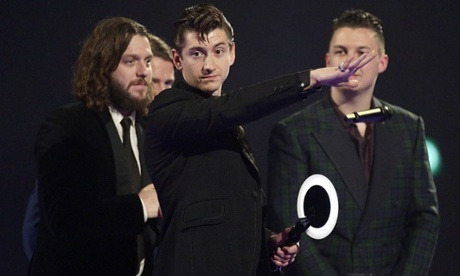
4. but to me, what makes mr. snarl camp is his performance of gender. now let's get one thing clear- camp is not effeminate or queer behaviour. it is the "spirit of extravagance", so any kind of extravagant and ironic presentation of gender can be under the purview of camp.
this performance of gender is not the david bowie or marc bolan or brian molko kind, no. this performance of gender is much subtle, much more nuanced- he wasn't playing around with rigid definitions of gender or crossing gender lines. he wasn't trying to say something with it necessarily. i doubt even, if it was a purposeful thing that he was thinking of back then.
but mr. snarl is a performance of gender. it is a performance of masculinity. and the thing that makes it so very interesting is that it was a cis, straight man doing it.
[if y'all are interested, another interesting example is dolly parton + her persona + her performance of exaggerated femininity. for more on that i'll point you towards be kind rewind's video essay on her.]
mr. snarl was an image of a very certain kind of masculinity. 1950s, elvis presley, rockabilly, greasers, james dean- these are some of the pop culture touchstones that come to mind when we think of mr. snarl. he is also decidedly american. a "fictional character from america" as alex later put it. was this whole persona thing an effort to conquer america then? perhaps...but eh. there is no way i can conclusively say that. it certainly helped that cause. AM the album was very us-american in essence-- it drew from hiphop and r&b after all. the soundscape of the arctic monkeys was very much rooted in its northern british indie roots, and AM was the first one that was clearly not. and mr. snarl was just a visual reflection of that. [for more on how the arctic monkeys conquered the us]
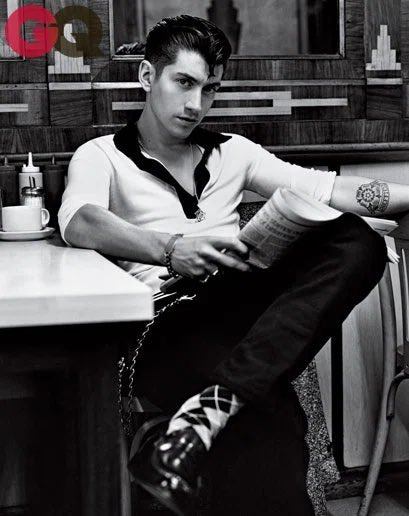

mr. snarl was a certain kind of masculine in a way alex turner personas haven't been previously or since. he has always presented as conventionally masculine. even the humbug persona- him being my girlfriend notwithstanding- is not much different from the aesthetics of say, ray davies or mick jagger or george harrison back in the 60s and 70s. the slightly effeminate dramaticism of eycte is not exactly gender-bending as such.
but mr. snarl was hypermasculine. masculinity has had an interesting place in his lyrics up until they- they are both critical ('brianstorm' 'a certain romance') and fascinated ('jeweller's hand' 'catapult') of more aggressive masculine characteristics. (he does use a lot of very sexual but not necessarily erotic language to describe said masculinity- but that's another can of worms.) mr. snarl was in a way, alex being those characters from those songs he was writing about. mr. snarl also very aggressively straight. straight with a capital s. his songs in AM still had the self-abasing and submissive undertones to the narrator that love songs from humbug and sias, but much toned down. he was out there shouting out his girlfriend on stage. and who can forget the "ladiessssssss!" moment. he had models hanging off him in photoshoots.

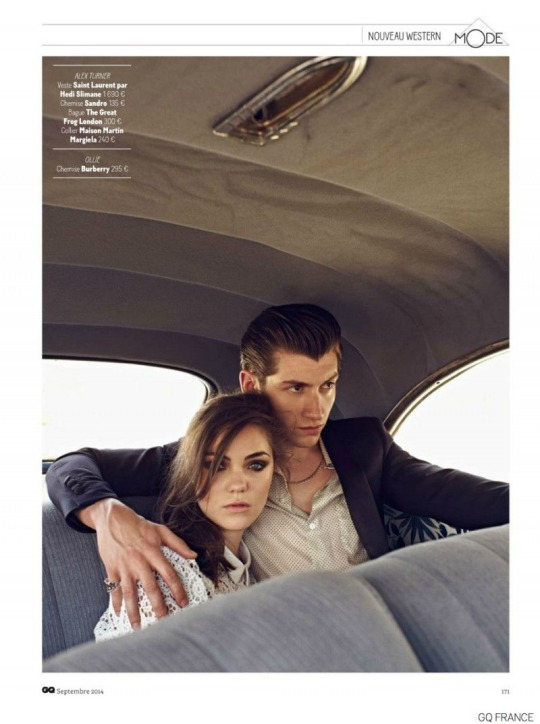
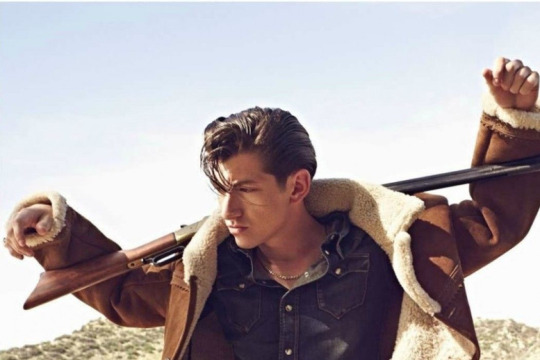

you probably saw these photos and thought- "what the fuck?!" with a cackle. that is exactly what makes mr. snarl camp. the irony, the ridiculousness of it all.
5. i don't think alex was trying to be or do camp. camp is best when it is not intentional. i can even confidently wager alex would not take it as a compliment if i showed him this essay. a lot of very "serious" people look down upon camp as something lowbrow and tacky and unserious. but it isn't. i would go ahead and classify mr. snarl under naive camp- he is trying to be straightlaced and serious, but failing grandly, which makes it deliciously camp.

so. mr. snarl was an exaggerated representation of masculinity. in a sense, mr. snarl was basically drag. alex turner being "Alex Turner".
#alex turner#arctic monkeys#the last shadow puppets#camp#susan sontag#i spent wayyyy to much time on this#journal of alex turner studies
149 notes
·
View notes
Text
If Caravaggio were alive today today, he would have loved the cinema; his paintings take a cinematic approach. We filmmakers became aware of his work in the late 1960s and early 1970s, and he certainly was an influence on us. The best part for us was that in many cases he painted religious subject-matter but the models were obviously people from the streets; he had prostitutes playing saints. There’s something in Caravaggio that shows a real street knowledge of the sinner; his sacred paintings are profane.
Martin Scorsese on Caravaggio
Michelangelo Merisi, known to most of us as “Caravaggio,” was born on September 29, 1571 in Milan, Italy, to parents who were from the small town of Caravaggio. In the span of his 38 years long life he revolutionised painting with innovations like a unique use of chiaroscuro - with dark shadows contrasting with dramatic areas of light - and a deep sense of realism that later inspired the Baroque movement. But most of all, he developed such an iconic style that most of us can probably look at a painting and know if it’s a Caravaggio, or Caravaggio-inspired.
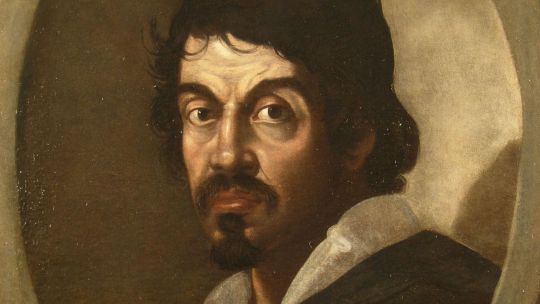
Merisi spent the first few years of his life in Milan, studying painting, and later moved to Rome, where his early talent impressed Cardinal Del Monte, who introduced the young painter to other high-profile Catholic figures who became commissioners of some of Caravaggio’s best work. It seemed there was no end to the artist’s creative genius. Caravaggio, much to his patron’s delight, would pump out one masterpiece after another. It seemed the more out of control his personal life became (cheating, brawling and murder were standard fare), the more his art would become more refined, more potent.
In the long list of masterpieces he left behind, both secular and religious works stand out. But it is perhaps in his religious works that the artistic transition of the master is more evident. Caravaggio is, in fact, known to have changed his style after harsh personal life experiences led him to reassess his outlook on life.
In May of 1606 Caravaggio took part in a deadly brawl in Rome and was charged with murder. He fled to Malta, in search of asylum from the Order of Saint John, a Catholic order dedicated to helping the sick and the poor. The order commissioned some of the most important late life works of the Milanese artist.
It is in these works that we notice the shift in Caravaggio’s art, from a strong focus on aesthetics to an interest in the spirituality of his subjects, which critics believe was motivated by his own introspection.
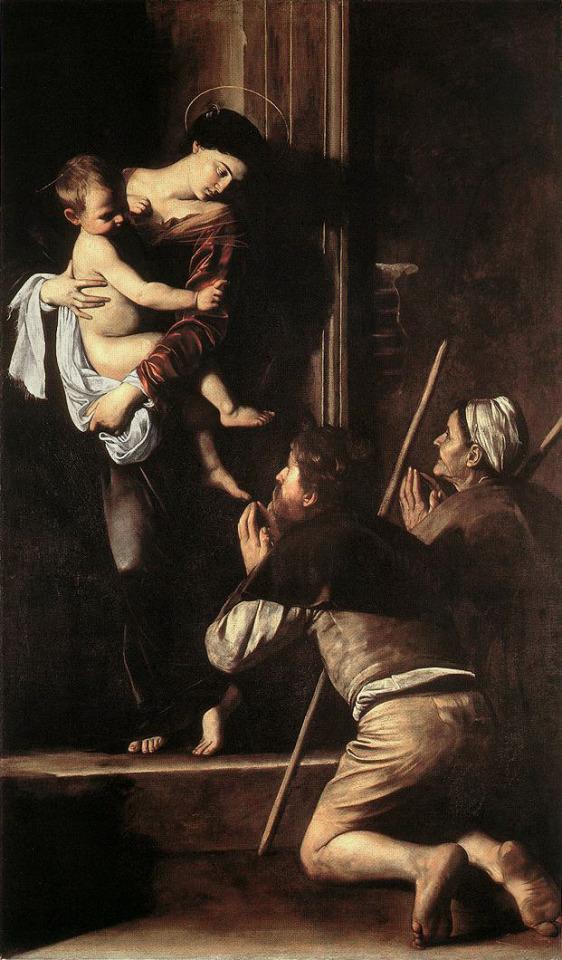
On the streets surrounding the churches and palaces, brawls and sword fights were regular occurrences. In the course of this desperate life Caravaggio created the most dramatic paintings of his age, using ordinary men and women - often prostitutes and the very poor - to model for his depictions of classic religious scenes.
By representing biblical characters in a naturalistic fashion, typically through signs of aging and poverty, Caravaggio's populist modernisation of religious parables were little short of trailblazing. Although not without his critics within the church, by effectively humanising the divine, Caravaggio made Christianity more relevant to the ordinary viewer.
For some, though, his art was too real. Bare shoulders, plunging necklines, severed heads; this raw humanity didn’t always fly in 17th century Rome. As a result, many of his pieces were rejected as altar pieces and as church hangings. One such piece, the Madonna of Loretto (now hanging in a church in Rome) was widely criticised upon its unveiling. The people of the day were shocked to behold the Mother of God leaning nonchalantly against a wall in her bare feet while holding baby Jesus in her arms.
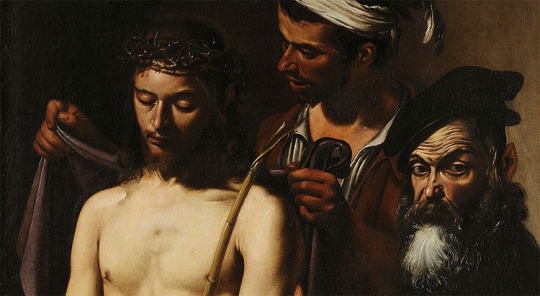
It is ironic that the very art that today we consider “classical” and “iconic” to the Catholic faith was considered questionable and perhaps void of modesty and virtue. Yet, the fact remains that no individual artist has made such a lasting impression on the world of modern art. Truly, many have called Caravaggio the “first modern artist”. It is no surprise, then, that his style has sparked both widespread admiration and imitation throughout the centuries.
Before Pope John Paul II refined a theology of the body beautiful, Caravaggio's paintings suggested a reverence for the inherent beauty of human form.
Troubled though he may have been, his art speaks eloquently of the dignity of the mundane. Though the original medium may be weathered and cracked, the message of beauty still echoes down the centuries. And this same beauty still fuels, escapes and reduces artists to relentless seekers as surely and as forcefully as it did in Caravaggio's life.
#scorsese#martin scorsese#quote#art#artist#caravaggio#art history#aesthetics#modern#sacred#profane#rome#catholic church#christian#beauty#realism#art of the mundane
400 notes
·
View notes